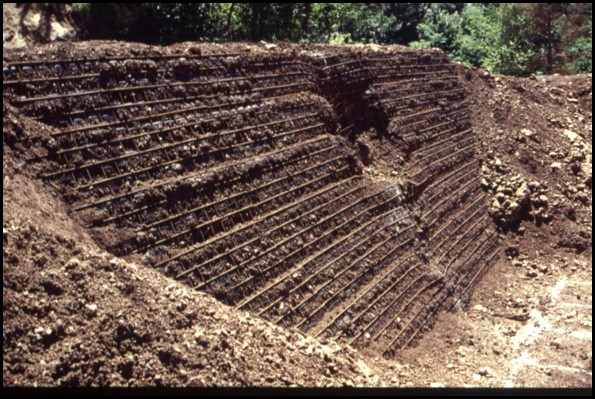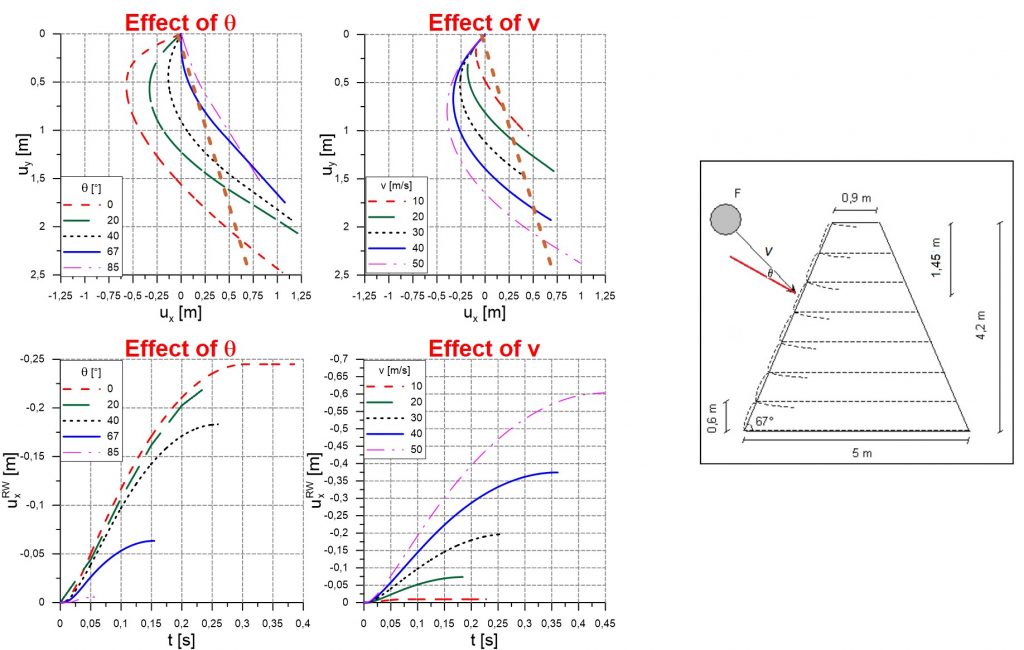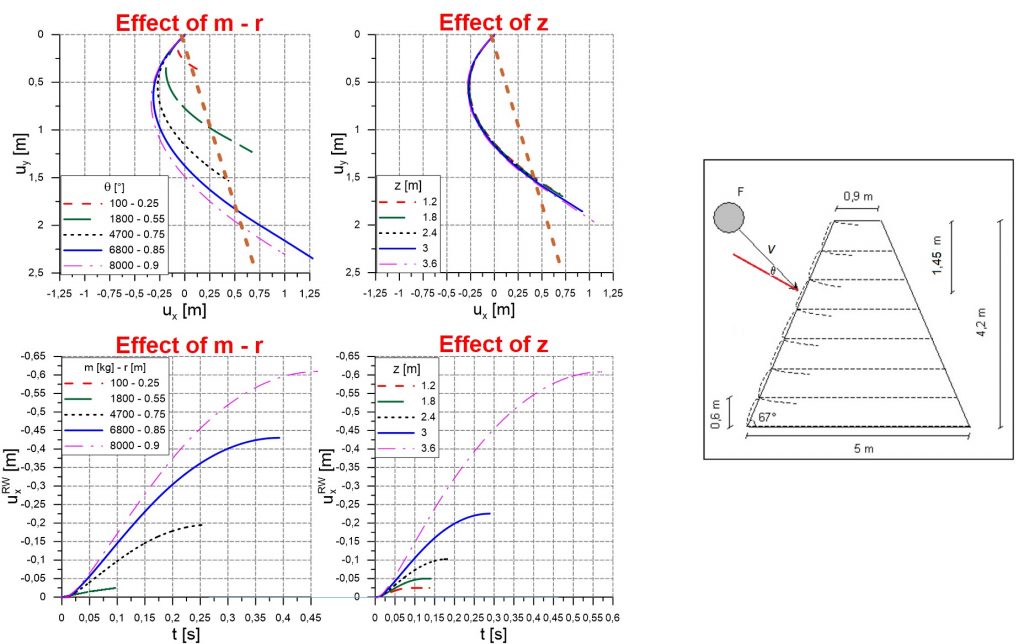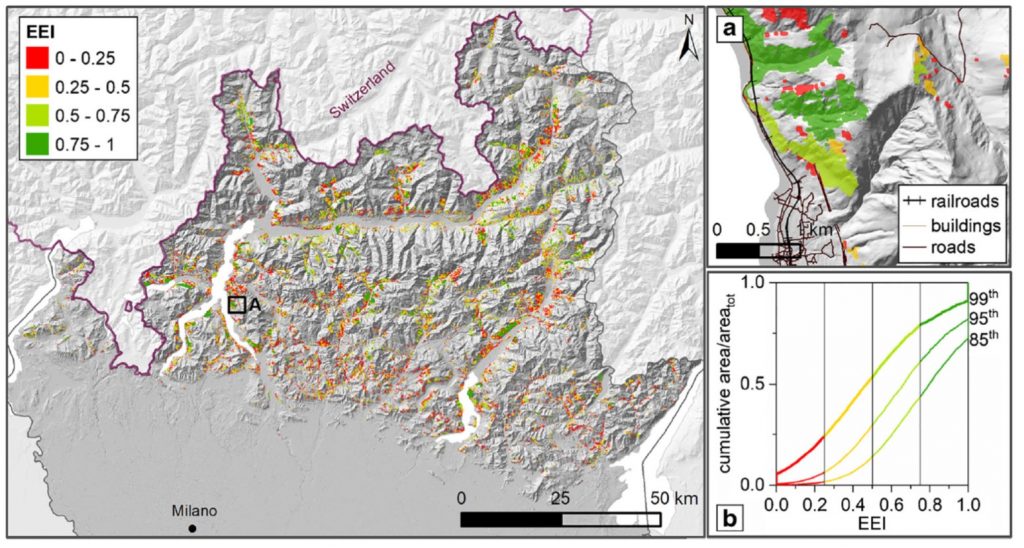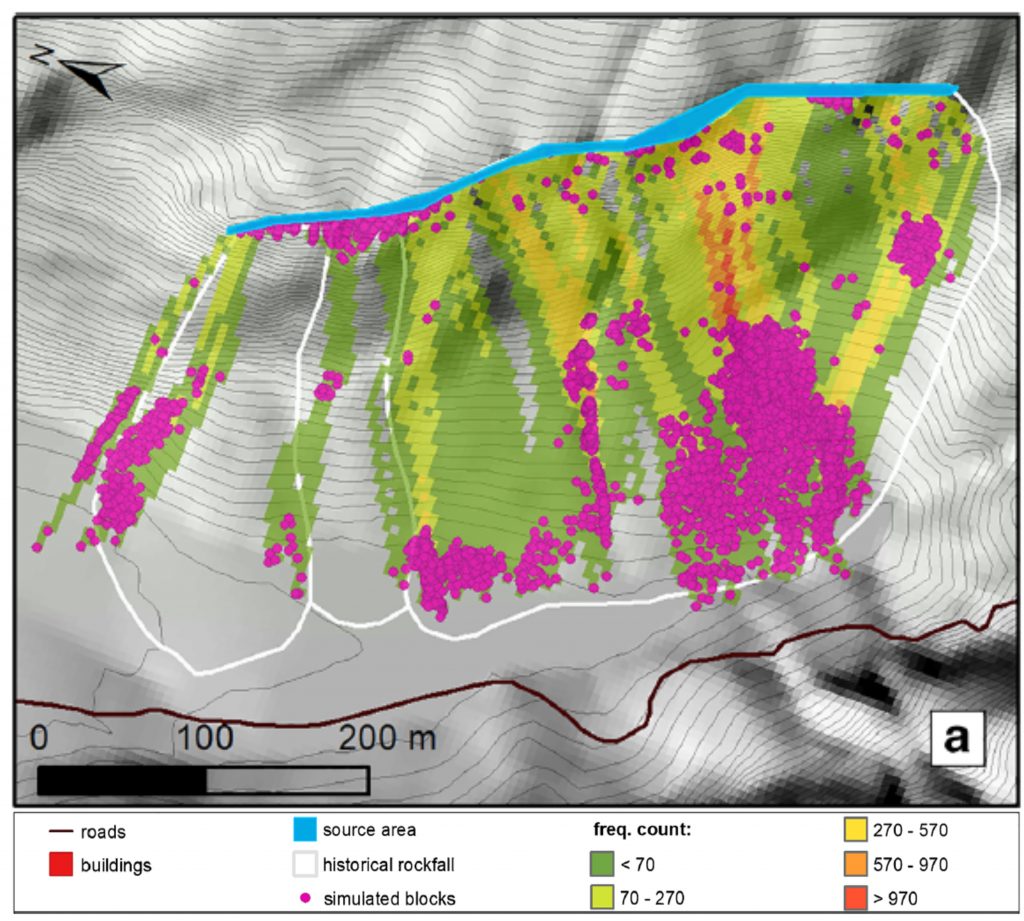[:it]
Obiettivi
Il WP è sviluppato in tre sotto-azioni:
3.1) Il codice 3D Hy-STONE sarà implementato introducendo nuove leggi di impatto per il rimbalzo e per l’impatto con strutture ed alberi. Inoltre, sarà implementata la possibilità di simulare corpi prismatici non simmetrici / irregolari. Il processo di frammentazione sarà modellato utilizzando approcci di meccanica semplificata delle fratture. Ciò consentirà di ottenere risultati più realistici, in particolare in caso di impatti caratterizzati da alti contenuti energetici.
3.2) Sarà sviluppato un nuovo strumento di modellazione per le agenzie regionali. Lo strumento includerà le funzioni più utili e di base di Hy-STONE, consentendo di eseguire simulazioni complete per singoli casi di studio e l’analisi dei costi e dei benefici, al fine di migliorare la mitigazione del rischio.
3.3) Definizione delle procedure di progettazione per l’uso di argini rinforzati, con lo scopo di migliorare le misure di mitigazione. Di fatto questo tipologia di struttura è abbastanza comune, ma fino ad ora non sono ancora disponibili in letteratura approcci convincenti e ben stabiliti.
Risultati
Definizione della legge di impatto
1) Attraverso l’utilizzo di un codice numerico DEM (PFC3D) per la simulazione di impatti di corpi sferici contro mezzi granulari sono stati simulati:
- impatti verticali su strati orizzontali
- impatti inclinati su strati orizzontali
- impatti verticali su strati inclinati
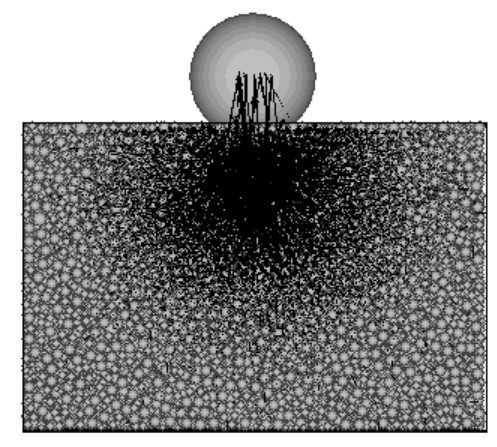
2) Analisi parametriche al variare del contenuto energetico dell’impatto, dello stato di addensamento del materiale, dell’inclinazione della velocità di impatto e dell’inclinazione dello strato.
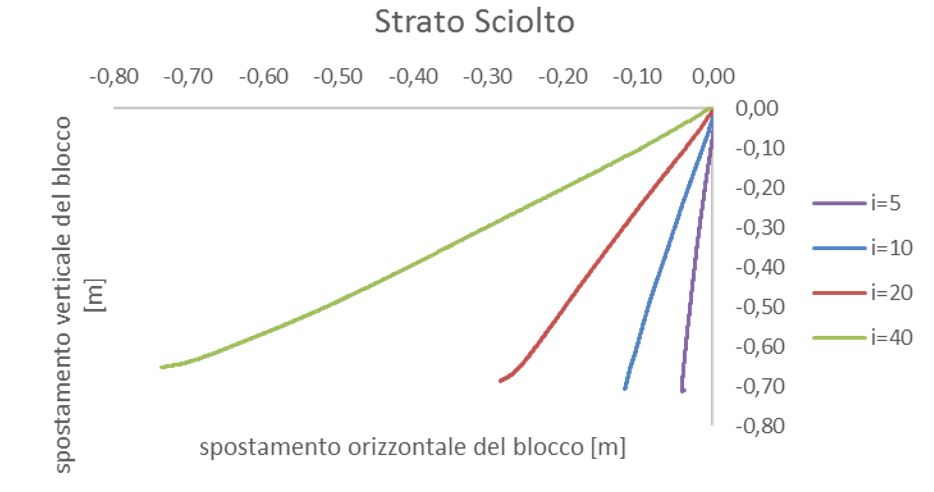
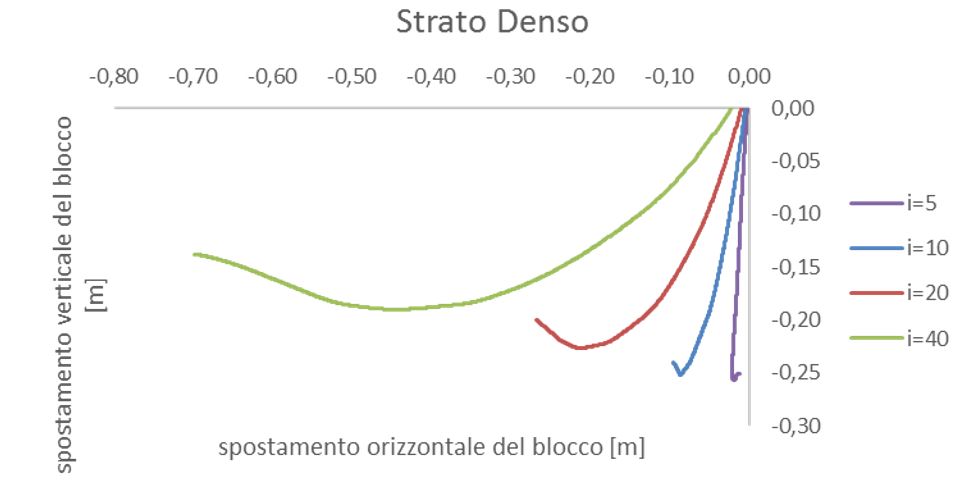
Modellazione reologica degli impatti
La modellazione del processo di impatto è stata eseguita sviluppando un innovativo modello reologico che consente di descrivere le forze di contatto che insorgono tra il blocco e lo strato impattato durante la loro interazione. Tale modello è frutto della combinazione di modelli più semplici, come mostrato nella figura sottostante, per il caso di componenti normali e tangenziali delle forze/spostamenti. Analogo discorso vale per le componenti rotazionali che possono giocare un ruolo determinante nella propagazione del blocchi durante il loro moto.

Questo approccio è molto versatile in quanto modificando opportunamente le leggi costitutive è possibile tenere in conto della geometria del blocco che sta impattando, della sua orientazione nello spazio e delle componenti cinematiche/dinamiche. A tal proposito oltre alla geometria sferica, tipicamente usata nello studio degli impatti e nelle applicazioni pratiche, ma semplificate, sono state considerate nel progetto geometrie più complesse. Sono state implementate leggi costitutive che simulano blocchi prismatici, a base regolare, con numero prefissato di lati e blocchi ellissoidici. Nelle due figure sottostanti sono rappresentate rispettivamente la sezione trasversale di un prisma a base quadrata, che impatta con un vertice e la sezione meridiana di un ellissoide, in cui l’impatto può avvenire secondo un’orientazione generica.
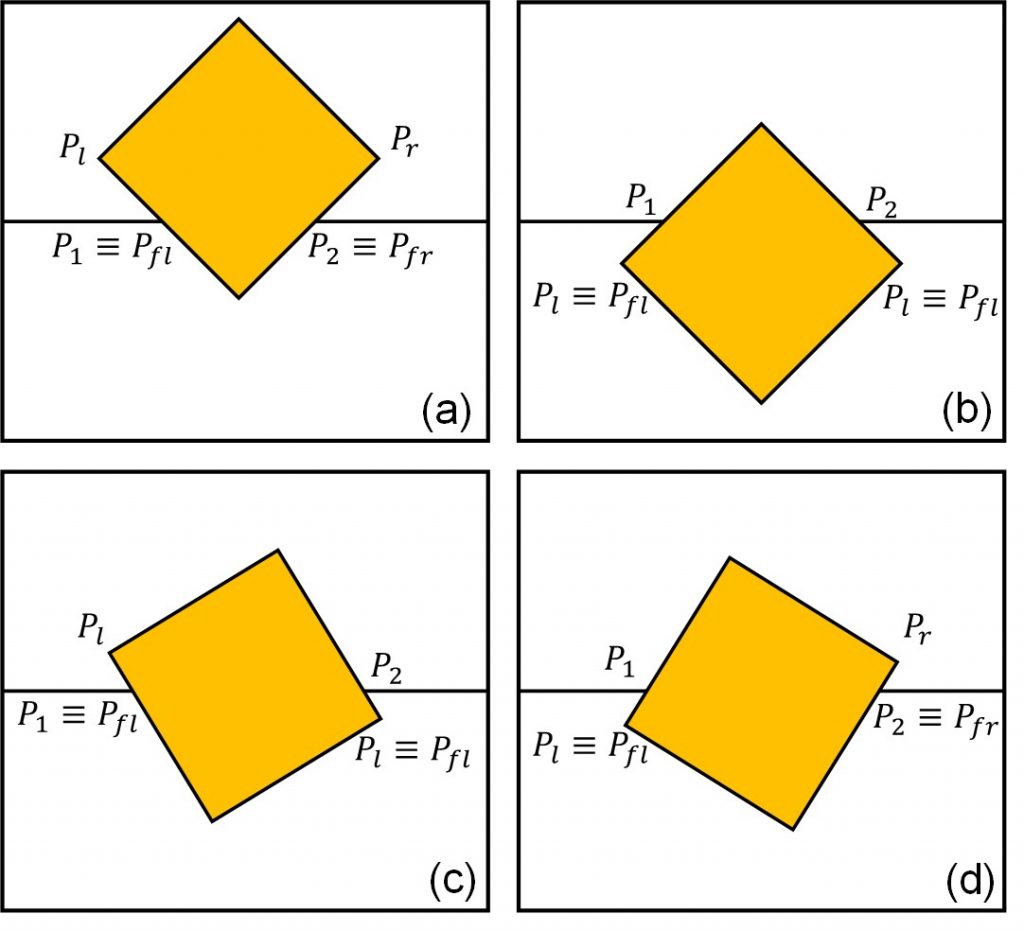
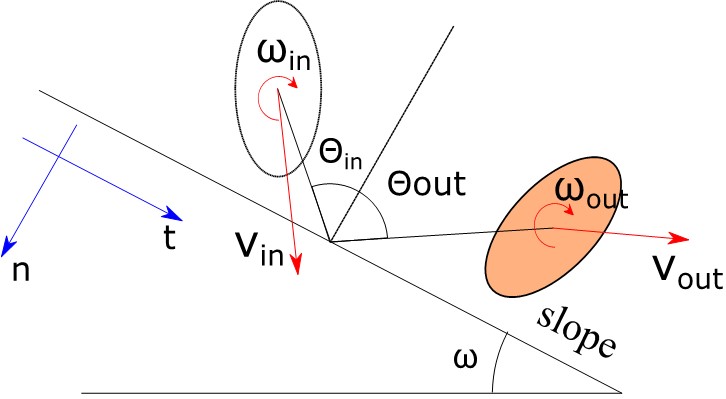
Nella figura sottostante sono riportati alcuni risultati di simulazioni numeriche realizzate tramite il modello reologico generalizzato per un caso con un pendio inclinato di 20°, blocchi prismatici di forma triangolare e sferici per diversi angoli di impatto. I risultati evidenziano i marcati effetti connessi alla geometria del blocco e all’angolo di impatto sui meccanismi e il moto del blocco durante l’impatto e immediatamente a seguito del rilascio. Tali effetti si ripercuotono sulla traiettoria e sulla energia di rotazione del blocco stesso.
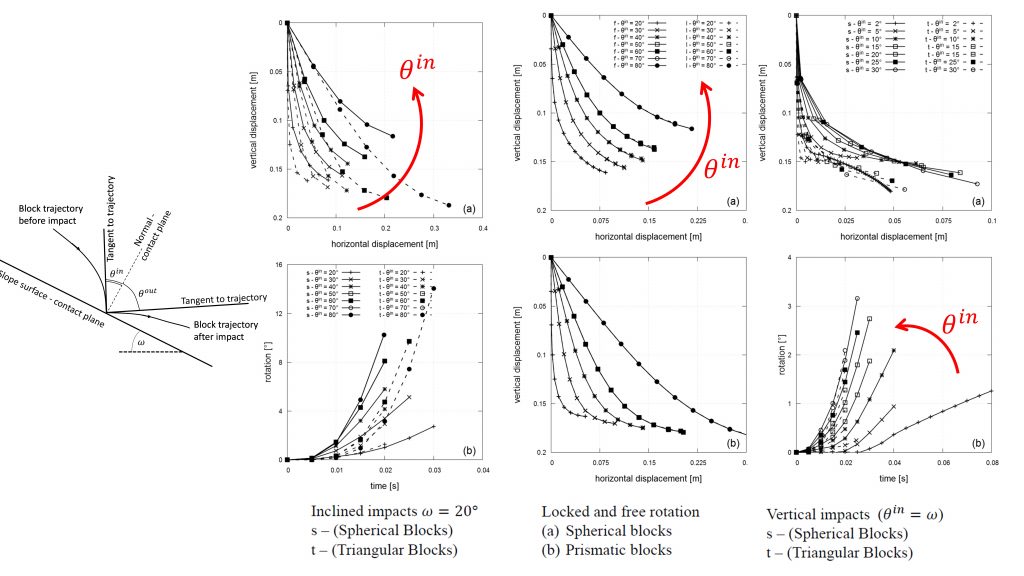
Per quanto concerne i blocchi ellissoidici sono stati considerati tutti i casi che vanno da impatti verticali ad impatti inclinati. Nel caso di impatti verticali si presentano i risultati per due orientazioni del blocco (lungo l’asse maggiore e quello minore) e differenti rapporti di forma. Nel caso di impatti inclinati oltre ai diversi rapporti di forma è simulata l’influenza di differenti angoli di impatto. I risultati sono mostrati nella figura sottostante in termini di spostamenti, forze verticali e coefficienti di restituzione normale e tangente associabili a tali condizioni di impatto.
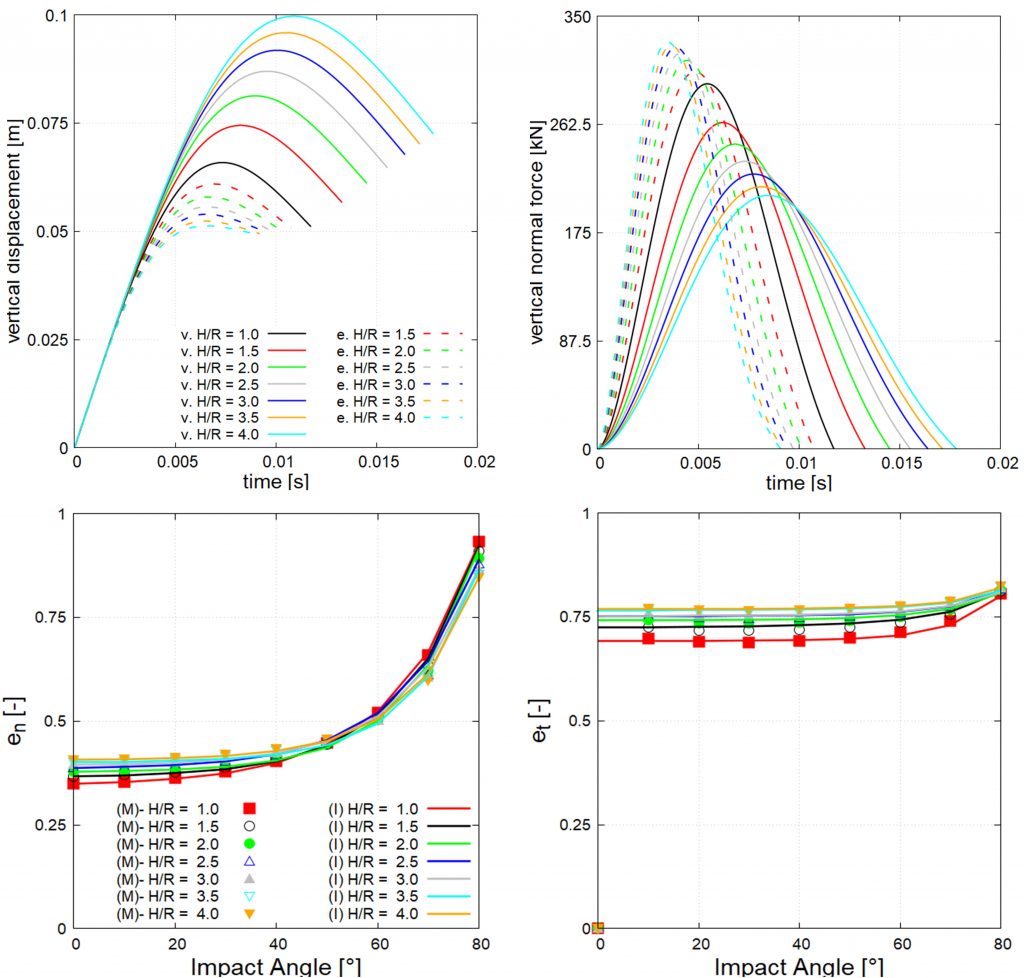
Ai fini di proteggere infrastrutture e centri abitati dai pericoli causati dalla caduta massi è uso comune la progettazione di opere di difesa quali reti e rilevati paramassi. Queste opere in terra sono realizzate tramite geotessili e geogriglie che consentono di costruire opere più snelle e di distribuire al meglio le forze che nascono al momento dell’impatto. Nella figura sottostante è riportata l’impronta di impatto a seguito dell’interazione di un blocco con un rilevato paramassi dove si evidenzia un affondamento del blocco dovuto ad un meccanismo di punzonamento che non ha causato la rottura globale dell’opera.
Per modellare l’impatto di un blocco contro un rilevato paramassi il modello reologico sviluppato durante il progetto è stato esteso tramite l’aggiunta di opportuni ulteriori elementi che consentono di modellare il comportamento del rilevato ed il meccanismo generato dall’impatto. Il modello è stato calibrato a partire da dati di prove in vera grandezza e successivamente impiegato per studiare gli effetti che differenti grandezze hanno sulla traiettoria del blocco, durante l’impatto, e sul meccanismo di punzonamento innescato all’impatto. I risultati di queste analisi sono riportatati nelle figure sottostanti.
Oltre a rilevati e reti paramassi, le coperture boschive svolgono un ben noto ruolo di protezione riconosciuto anche in leggi di difesa del territorio. Un blocco può essere deviato oppure arrestato dall’impatto con il fusto di un albero in funzione delle caratteristiche del moto e dell’ostacolo. L’effetto di una zona boscosa dipende da numerosi fattori tra cui la densità di alberi, il diametro del fusto (rappresentativo della maturità del bosco) e il tipo di albero (resistenza all’impatto). Al fine di valutare l’effetto protettivo del bosco viene proposto nell’ambito del progetto un coefficiente di efficienza (EEI) in base al quale le coperture boschive della regione Lombardia, poste in prossimità di infrastrutture e centri abitati, possono essere classificate e mappate attribuendo ai boschi un grado di protezione. La figura sottostante mostra i risultati ottenuti.
La suddetta mappa è frutto di simulazioni numeriche ottenute con il codice di caduta massi Hy-Stone che tiene conto per mezzo di un metodo stocastico della presenza degli alberi. La figura sottostante mostra le frequenze di passaggio dei blocchi nelle varie zone considerando un’area sorgente prefissata (linea azzurra) i risultati mostrano la validità delle simulazioni in quanto i blocchi ricadono all’interno delle zone delimitate con la linea bianca che sono quelle individuate mappando crolli avvenuti in passato.
[:en]
Objectives
The WP will be developed in three sub-actions:
3.1) The fully 3D code Hy-STONE will be implemented by introducing new impact laws for rebound and for the impact with structures and trees. Moreover, the possibility to simulate non symmetrical/irregular prismatic bodies will be implemented. The fragmentation process will be modelled by using simplified fracture mechanics approaches. This will allow to obtain more realistic results, in particular in case of impacts characterized by high energetic contents.
3.2) A new dedicated modelling tool will be developed from Hy-STONE for regional agencies. The tool will include most useful and basic features of Hy-STONE, and will allow regional agencies to fully run simulations for single case studies and for the analysis of risk and mitigation measure cost and benefits.
3.3) Design procedures for the use of reinforced embankments as mitigation measures will be provided. In fact, these type of structures is quite common but up to now convincing and well established approaches are not yet available in the literature.
Results
Definition of impact law
1) Simulation of impacts of spherical bodies against granular media with the use of a DEM numerical code (PFC3D)
- vertical impacts on horizontal layers
- inclined impacts on horizontal layers
- vertical impacts on inclined layers

2) Parametric analysis to vary the energy content of the impact, the state of thickening of the material, the inclination of the impact speed and the inclination of the layer.
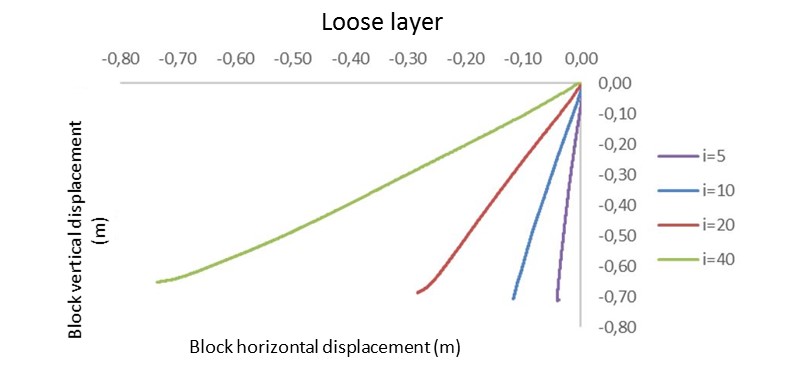
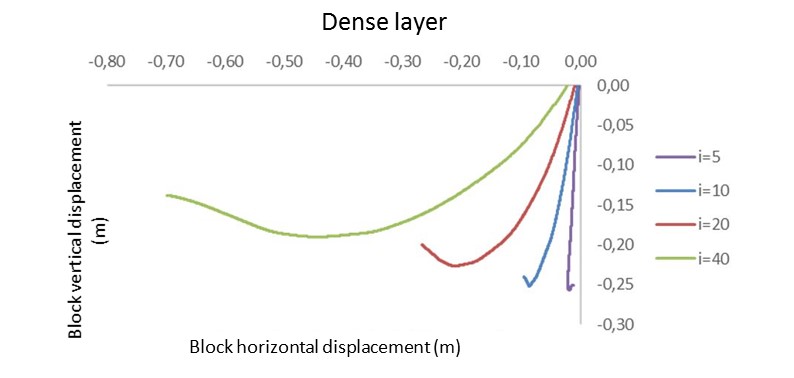
Reological modelling of the impact
The modelling of the impact process has been performed developing a new reological model that allows the description of contact forces taking place between the block and the stratum during their interaction. Such model is a combination of elementary sub-models as shown in the figure below for the case of normal and tangential force/displacement components. Analogous considerations can be done for the rotational component that may play an important role in the blocks propagation during their movement.

Such modelling approach is very flexible since a suitable modification of the constitutive laws allows taking into account the impacting block geometry, its orientation in the space and the kinematic/dynamical components. Therefore, aside from the spherical shape, typically employed in the impact studies and in practical applications, but very simplified, complex geometries are taken in to consideration in the project. Constitutive laws, simulating prismatic blocks with regular base with prefixed number of edges and ellipsoidal blocks have been implemented. The figures below show the cross section.of a prismatic block with square base, impacting with vertex, and the meridian section of an ellipsoidal blocks which can impact with a generic orientation.


Some results of numerical simulations obtained by means of the generalized rheological model for the case of a slope inclined of 20° are reported, considering a block with both triangular prism and spherical shapes for different impact angles. The results highlight the marked effects due to the block geometry and the impact angle on the mechanism and block motion during the impact and just after the release. Such effects influence significantly the block trajectory and its rotational energy.

When ellipsoidal blocks are concerned, all possible inclinations are taken into account ranging from vertical to inclined impacts. In case of vertical impacts, the results of two orientations (along the major and minor axes, respectively) are shown for different values of the aspect ratio. In the case of inclined impacts, in addition to the different aspect ratio, the influence of the impact angle is simulated. The results are plotted in the figure below in terms of displacement, vertical force and normal and tangential restitution coefficients associated with that impact conditions.

In order to prevent hazardous rockfalls on facilities and settlements, usually some protection structures such as net fences and retaining walls are designed and built. These structures are constructed by soil reinforced with geotextile and geogrid, which allow increasing their slenderness, and to better distribute the force generated by the interaction between the block the reinforced wall. In the figure below the mark generated by the interaction between a block and a retaining wall is shown together with block sinking due to the punching mechanism which, in this case, did not result in the total failure of the building.
To model the impact of the block with a retaining wall, the rheological model developed during the project has been extended by adding other suitable elements that are able to model the retaining wall behaviour and the impact mechanics. The model parameters have been calibrated from data of real scale tests and subsequently employed to study the effects of many parameters on the block trajectory during the impact and the punching mechanism triggered by the impact. The results obtained are shown in the figures below.
In addition to the net fence and the retaining wall, forests have a well-known role in rockfall propagation that has been recognized by many laws issued for land protection. A block may be deviated or stopped during the impact with the tree stems, depending on the characteristics of the movement and on the obstacle. The effects of wooded area depend on the tree density, the stem diameter (representing the maturity of the forest) and type of trees (resistance at impact). In order to evaluate the protective effects of the wood tress, it has been proposed in the project an efficiency coefficient (EEI) according to which the wooded area of Lombardia region, in proximity of infrastructure and inhabitants centres, may be classified and mapped assigning to the trees a protection degree. In the figure below, the obtained results are shown.
The above map is the result of numerical simulations obtained by means free fall code Hy-Stone that takes into account of the tress presence by means of a stochastic method. The figure below shows the passage frequency of blocks in the different zones, considering a prefixed source area (cyan line). The results demonstrate the validity of the simulations since the blocks released within zones bordered by a white line that have been located by mapping previous falling.
[:]
